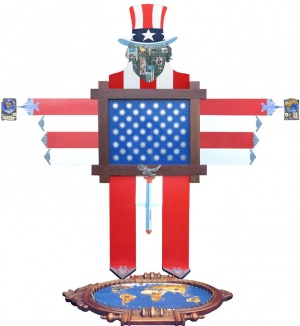In 2003, the United States invaded Iraq on the charge that it produced weapons of mass destruction and that it supported al-Qaeda, a terrorist group accused of attacking the two towers in New York and the Pentagon in Washington DC. At the time, CIA director George Tenet had previously informed President Bush that Iraq did not produce the weapons mentioned and had no connection to al-Qaeda, whose chief Bin Laden, was in Afghanistan.
Still, Bush, aided by the United Kingdom, Australia and other nations, decided to invade Iraq.
After the invasion none of the charges were proven and the invasion created a destabilization of Iraq that culminated in the birth of the ISIS terrorist group.
The work called the Bush Doctrine - The Scarecrow of Death represents my opinion on American military actions in various parts of the world in the name of a policy that I consider to be wrong and malicious.
The vertical part of the painting represents the image of “Uncle Sam” (symbol of the USA). In the head there are several images showing Bush calling for the invasion and playing to dominate the world, as well as military armaments, world demonstrations against the invasion etc.
The trunk and arms are formed by allusions to the American flag. The white and red strips act as a trail left by six B-2 Spirit stealth planes and two F-21 fighters that simultaneously threaten the world continents that are inside of two HDs with the inscription "We" in several opposing languages to the inscription “US”, which also means “We” in English and at the same time United States.
The fifty stars of the USA flag are represented by spurs, in an allusion to Bush's Texan origin. The tails are represented by an eagle and the penis by a Tomahawk missile. The feet are represented by two Nighthawk F-117 stealth planes.
On the floor, a world map surrounded by bullets has several American flags planted on the continents representing the country's military presence in the world and the areas of the United States and the United Kingdom are filled with electronic circuit boards.
TECHNIQUE: OIL + OBJECTS ON WOOD
DIMENSIONS 205 X 185 CM (520 in X 470 in)
YEAR: 2003
* Used objects: Sawed and polished computers boards, spurs, disassembled HDs, brooches, acrylic, ornamental objects, etc.
Walter Miranda - 2003
Bush Doctrine - The Scarecrow of Death by Flávia Miranda
Among many others interesting pieces of artistic works, The plastic artist Walter Miranda presents a panel with works of art that provoke deep reflections about the Bush’s current political world. In the panel, there are works criticizing the current North American politics (called doctrine Bush) and the terrorist actions. At the same time, the artist exposes works honoring New York City, victim of the attacks of September 11, 2001. The works join the traditional technique of the oil painting (in contemporary style) with the new technological medias (because part of the works was accomplished through graphic computation). A work stands out of the group: BUSH DOCTRINE - SCARECROW OF DEATH. It consists of a scarecrow with the same high and breadth wise of an adult man with the world map at his feet. The work is painted with synthetic enamel and oil painting, with the insertion of sawed computer plate, disassembled HDs, brooches, bullets, spurs, images worked with graphic computation, etc. It represents a critic to the political actions of the president Bush in the world. It is such a picture as an installation, because it extends from the wall to the ground, inducing the spectator to look it from several points of view and to interact with the art object. The different images and parts that compose the work are linked to each other but at the same time they are independent. They provoke a thoughtful glance of the details and a dynamic glance due the reasoning correlation between the parts and the whole. Certainly it is an impressive work that leads to intelligent reflection on the current world political map. It is an outstanding exhibition of strong visual impact and conceptual aims but with subtleness in the implied sense.
São Paulo, April, 2004. Flávia Venturoli Miranda
